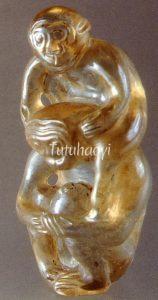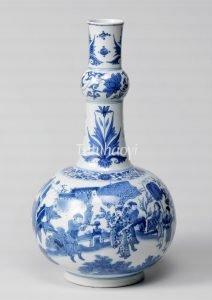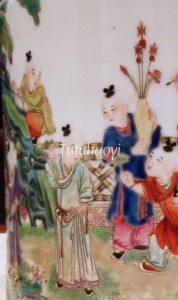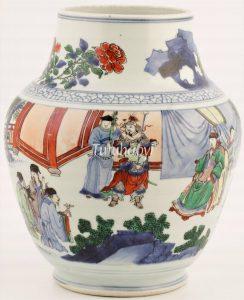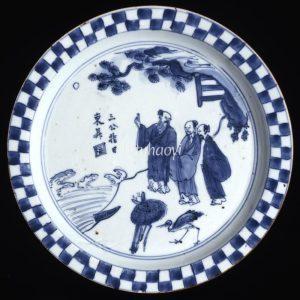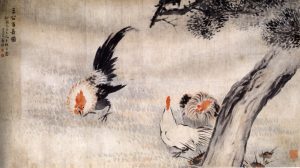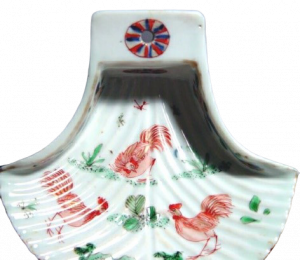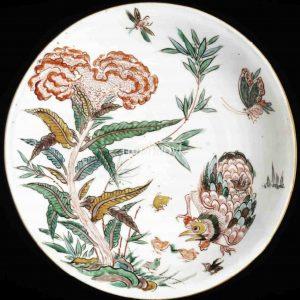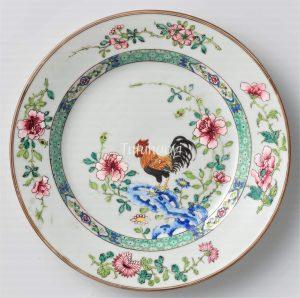Showing Results Containing
When you mistake a motif in a traditional Chinese picture, you could have misinterpreted the meaning of the whole image intended by the ancient craftsman. Dr Yibin Ni has used the following example to illustrate the hidden meaning of a series of i...
In Chinese porcelain painting, it can be tricky to interpret a round disc in the sky as a sun or a moon. Knowledge of Chinese culture and pun rebuses are the keys to explain the meanings of the motifs and scenes correctly. Here are some examples…<...
Pun Design:
Carrying on the Back + Monkey
Punning Details:
– ‘bei 背’ for ‘carrying on the back’ makes a pun on ‘bei 辈’ for ‘generation’
– ‘hou 猴’ from ‘hou zi 猴子’ for ‘monkey’ puns on ‘hou 侯’ for ‘marqui...
Pun Design :
Official Hat + Wine Vessel
Punning Details:
The combination of ‘jia 加 putting on’ and ‘guan 冠 hat’ – ‘jia guan 加冠’ is a pun on ‘jia guan 加官’, meaning ‘receiving an official title...
The main figure in the scene is a dignitary, often gripping a hu (笏) tablet in his hands, which an official uses to take notes when he has audience with the emperor in court. He is usually sheltered by page boys erecting some fans or a parasol or guarded by a soldier holding a weapon with an iron melon on the to...
A variation of 平升三级 ping sheng san ji (May you have three successive promotions unexpectedly) is 连升三级 lian sheng san ji. The design h...
The Chinese character for ‘monkey’ is 猴 hou and it puns on the word for ‘marquis’ in Chinese 侯 hou. The expression ‘mashang 马上’ in Chinese is ambiguous in that it can mean, literally, ‘on a/the horse’, or it can mean, idiomatically, ‘right away’. Therefore, an image of a monkey on the back of a...
The story scene is originated from an anecdote dating back to the Tang dynasty (618-907). Cui Rong (崔戎, 780-835) is a statesman who is important enough to have a position in the ‘Biographies’ section in the official histories The Old Book of Tang (jiu tang shu 旧唐书), completed in 945, and the New Book of Tang (
This pun rebus picture consists of four essential pictorial elements: bird,
The ancient Chinese would employ a picture of a monkey reaching for a bee hive to wish their boss an imminent promotion. The word for bees in Chinese is ‘feng 蜂’ and the word for monkeys is ‘hou 猴’. When ‘feng’ and ‘hou’ are put together, they can form the phrase 封侯 which means ‘be bestowed a rank of nobility’ in Chinese...
The action of ‘pointing to the sun’ is termed in Chinese as ‘指日 zhi ri’, which sounds and looks exactly the same as (both homophone and homograph of) the phrase ‘指日 zhi ri’ meaning ‘in a few days’ time’. The state of ‘something rising high up’ is ‘高升 gao sheng’ in Chinese, which may be metaphor...
‘San gong 三公’ are the ‘Three Top Lords in the Imperial Court’. The ‘gong 公’ from the Chinese name ‘gong ji 公鸡’ for ‘rooster’ puns on the Chinese name for ‘lord’ and three roosters in the picture represent the three top lords, which are the three top positions in the imperial court. The Chinese ...
‘San gong 三公’ are the ‘Three Top Lords in the Imperial Court’. The ‘gong 公’ from the Chinese name ‘gong ji 公鸡’ for ‘rooster’ puns on the Chinese name for ‘lord’ and three roosters in the picture represent the three top lords, which are the three top positions in the imperial court.
...
The saying ‘jia guan 加官’ is an abbreviated form of the saying ‘guan shang jia guan 官上加官’:
‘Guan 冠’ in the Chine...
‘Guan 冠’ in the Chinese name ‘ji guan hua 鸡冠花’ for ‘cockscomb’ is a pun on ‘guan 官’, which means ‘high-ranking official’. The crest on the head of a rooster is also called ‘guan 冠’ in Chinese. Thus, the appearance of both the cockscomb and rooster in a picture represents the auspicious...
The Chinese phrase ‘Gong ming 功名’ for ‘scholarly honour or official rank’ is a pun on two Chinese characters ‘gong 公’ and ‘ming 鸣’.
‘Gong 公’ from ‘gong ji 公鸡’, the Chinese name for ‘rooster’, makes pun on the Chinese word ‘gong 功’; and ‘ming 鸣’, which ...


